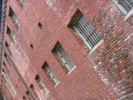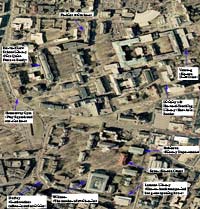I’m sitting in small café called “Fango” at Seoul University’s Language Education Institute (LEI). I arrived in Seoul yesterday and I’m here until mid-August to study Korean.
A storm is raging outside while some ’60s-sounding Norwegian song (the second one in less than half an hour!?) is playing over the café speakers. Although I’m not sure when this blog posting will hit the net, at the present moment (June 1st), I’m homeless. The room in the International Student dormitory that I was supposed to move into this afternoon is still occupied by the resident I was to replace. After going to the dorm and discovering my room still occupied, I was informed by phone the details by the LEI office and summoned back to the school for consultation on my predicament. There were some half dozen things about this program that had already angered me so I was prepared to take a hardline with the office administrators about my dormitory predicament.
I was completely disarmed when the dormitory administrator told me, “he took complete responsibility” and offered to let me stay in his room in the same dormitory that evening if the former resident had not moved out by the evening (he is apparently trying to get a ticket out of the country). “I’ll take the floor and you can have my bed.”
It isn’t the first time I have experienced generosity here. If I stop too long on the streets with a map in my hand someone offers, in English, to help me find my way. At the airport, a random stranger stepped up to tell me I was trying to use a phone card in the wrong brand phone and then walked me over to the correct phone. Today, after discovering that the buses don’t give change for a 10,000 won note when you pay a 900 won fare, the bus driver refused to drive on without me and told me he would wait while I popped into a nearby convenience store to get some change, which I promptly did.
I spent a wonderful couple of days in Takarazuka hanging with Sayaka‘s family. We made a trip into Osaka to give me a look around the city and in addition to recovering from jet lag, I felt like I was being fed delicious food constantly.
Here in Korea, I’m completely lost. I had some bizarre Korean-Japanese fusion food yesterday at a “Hot Noddle” shop where I ordered some Kimchi Udon and Fish Dumplings. I wanted to order a drink but the only option on the wall menu was “Cock / Cider” (this item was only written in English) and I wasn’t 100% confident that they meant Coca-cola.
In all of my half dozen or so “in the field” conversations in Korean so far, I’m suffering from a huge problem: I’m usually getting across, in some way or other, what I want to say in my broken Korean and perhaps a bit of wild gesticulation. Then, after kindly complementing me on my horrible language skills, they reply to me in lightning fast Korean and I have no idea what they are saying. Asking them to slow down reduces the speed to something a little bit short of Mach 5 but still too fast for me to distinguish one word from the next.
Classes start next week so I have plenty of opportunities to get a bit more accustomed to daily life here, assuming of course, I have a place to live sometime in the next few days. I’ll post this and other postings when my laptop gets some internet access.
UPDATE: The resident I was to replace moved out this evening so I am moved into my room in the international student dormitory.



 So last night I was in an underground shopping mall in Jongno looking for a bathroom. I thought I had found one until I approached the sign and noticed it was a little bit different than what I was expecting. Could Korea, one of the most conservative countries in the world, actually have co-ed bathrooms? The woman on the sign has even done her hair up for the occasion! No, of course not, closer inspection revealed that the sign was showing the way to a small clothes store. They’re messin’ with my symbols and forcing my brain to accept new information! Ah…nothing like traveling to other countries to give one’s brain an occasional jolt.
So last night I was in an underground shopping mall in Jongno looking for a bathroom. I thought I had found one until I approached the sign and noticed it was a little bit different than what I was expecting. Could Korea, one of the most conservative countries in the world, actually have co-ed bathrooms? The woman on the sign has even done her hair up for the occasion! No, of course not, closer inspection revealed that the sign was showing the way to a small clothes store. They’re messin’ with my symbols and forcing my brain to accept new information! Ah…nothing like traveling to other countries to give one’s brain an occasional jolt.